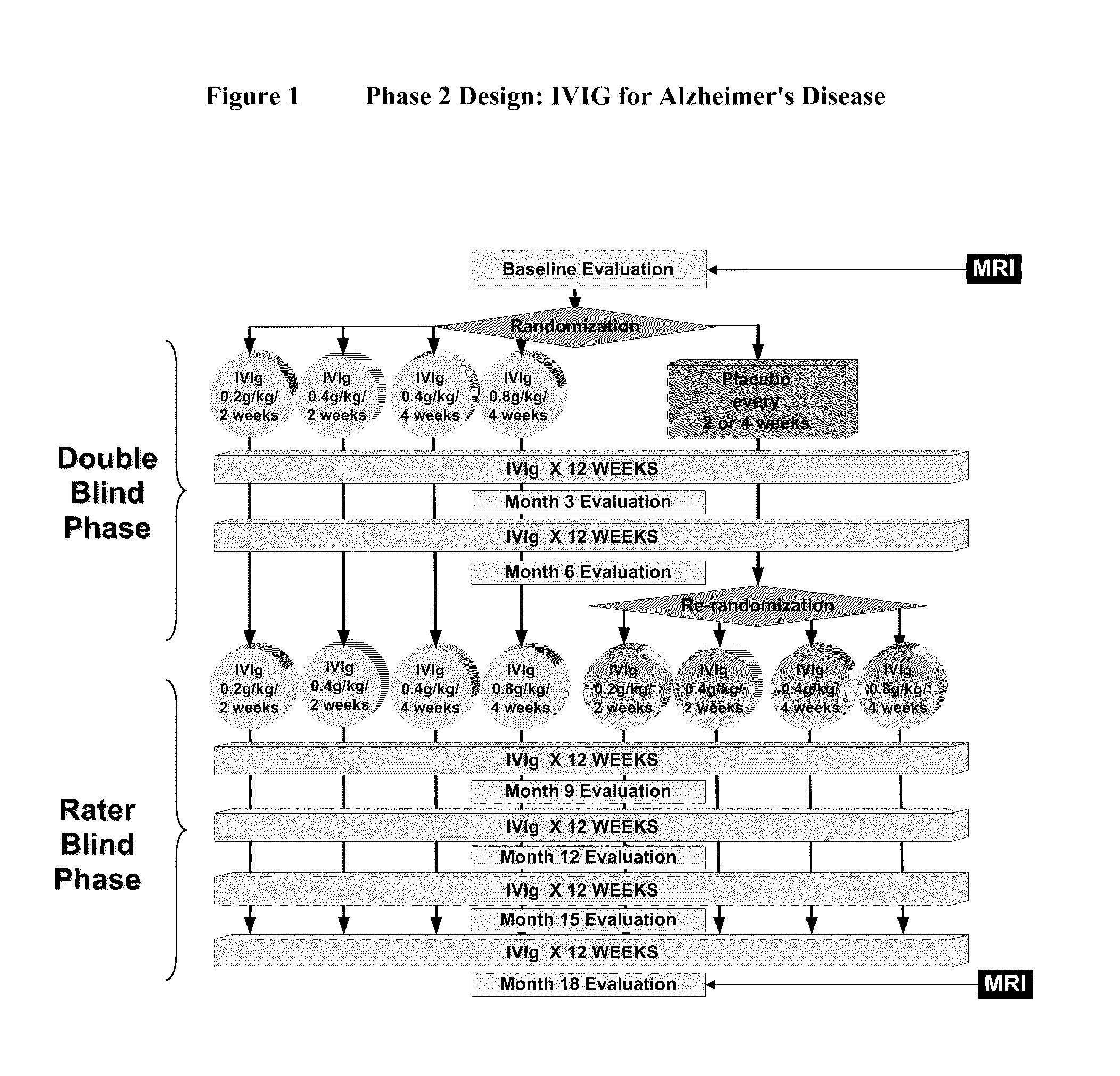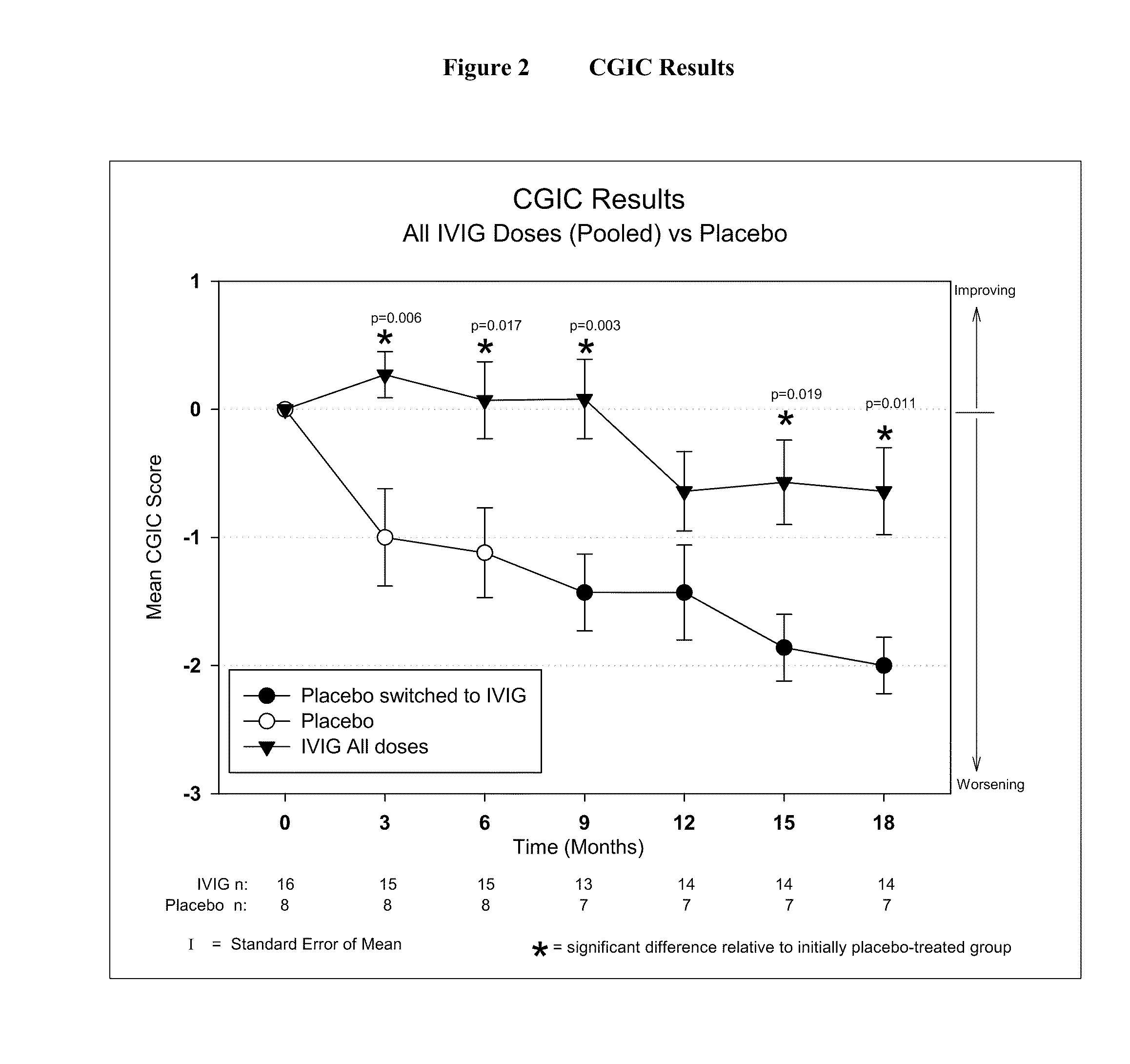Use of ventricular enlargement rate in intravenous immunoglobulin treatment of alzheimer's disease
a technology of immunoglobulin and ventricular enlargement, which is applied in the field of use of ventricular enlargement rate in intravenous immunoglobulin treatment of alzheimer's disease, can solve the problems of neurotransmitter level reduction, neural cell death, and behavioral problems, and achieves the effects of reducing emotional stability, behavioral problems, and reducing neurotransmitter levels
- Summary
- Abstract
- Description
- Claims
- Application Information
AI Technical Summary
Benefits of technology
Problems solved by technology
Method used
Image
Examples
examples
[0045]The following examples are provided by way of illustration only and not by way of limitation. Those of skill in the art will readily recognize a variety of non-critical parameters that could be changed or modified to yield essentially the same or similar results.
example i
Neuropsychological Outcomes Following 18 Months of Uninterrupted Intravenous Immunoglobulin (IVIG) Treatment in Patients with Alzheimer's Disease
[0046]IVIG Phase 2 Study Design: The study was a randomized, double-blind, placebo-controlled, parallel arm, add-on clinical trial testing safety and utility / futility of IVIG treatment for Alzheimer's Disease (AD). 24 subjects with mild to moderate AD (as determined by MMSE 14-26) participated in the trial. For the placebo group, a 6-month placebo period was controlled with a 12-month open-label extension. Primary clinical outcomes were measured by ADAS-Cog and CGIC, where a positive outcome was predefined as a difference of at least 1.7 ADAS-Cog points at 6 months in IGIV group and numeric superiority on CGIC. Secondary clinical outcomes were measured by NPI, ADCS-ADL, QOL, 3MS, and neuropyschological battery. FIG. 1 provides an outline of the study design.
[0047]Dosage range: IVIG infusion was given at the frequency of once per 2 weeks or ...
example ii
Intravenous Immunoglobulin Treatment Decreases Rates of Ventricular Enlargement and Cognitive Decline in Alzheimer's Disease
[0056]Objectives: To examine the effect of 18 months of intravenous Immunoglobulin (IVIG) treatment on ventricular enlargement rates in mild to moderate Alzheimer's disease (AD); to examine the correlation between ventricular enlargement rates and clinical outcomes in AD patients treated with IVIG.
[0057]Neuronal loss during normal aging causes brain atrophy (or shrinkage). Neuronal degeneration in Alzheimer's Disease, however, causes accelerated brain atrophy. As the human skull is a closed space, brain atrophy leads to progressive enlargement of the fluid-filled cerebral ventricles. The rate of ventricular enlargement over time provides an objective measure of the rate of Alzheimer's disease progression.
[0058]Different ventricular enlargement rates have been observed in normal, mild cognitive impairment (MCI), and Alzheimer's disease brains. It has been report...
PUM
| Property | Measurement | Unit |
|---|---|---|
| Time | aaaaa | aaaaa |
| Time | aaaaa | aaaaa |
| Time | aaaaa | aaaaa |
Abstract
Description
Claims
Application Information
 Login to View More
Login to View More - R&D
- Intellectual Property
- Life Sciences
- Materials
- Tech Scout
- Unparalleled Data Quality
- Higher Quality Content
- 60% Fewer Hallucinations
Browse by: Latest US Patents, China's latest patents, Technical Efficacy Thesaurus, Application Domain, Technology Topic, Popular Technical Reports.
© 2025 PatSnap. All rights reserved.Legal|Privacy policy|Modern Slavery Act Transparency Statement|Sitemap|About US| Contact US: help@patsnap.com



